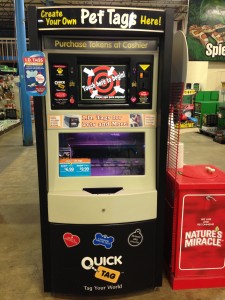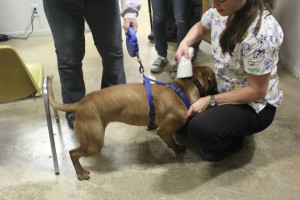Have you ever lost a pet? Maybe your cat or dog slipped out an open door or through an open gate in your back yard? If you’ve ever experienced the panic and stress of a lost pet, then you may already know the importance of having some form of pet identification on your pet to help them find their way home to you! Accidents happen. Sometimes pets are scared, sometimes they’re curious, sometimes they just like to run. I used to have a “runner”. The Jack Russell would, upon seeing even a small chance to escape the house would seize the opportunity, running for miles through yards, across streets without a destination in mind, simply running to run and without desire to be captured or return. On more than one occasion I was able to pursue and capture my wiley pet, but there were one or two times when I returned to my home distraught after losing sight of him, thinking the worst that I might never see him again. Fortunately, he never went on a joy run without his collar, which not only held his license, but also a simple ID tag, etched with his name and my phone number…perhaps the best couple of bucks I spent since it was that little tag that brought my dog back to me.
Just a few minutes of your time and a few dollars from your wallet can mean the difference between losing a pet forever and having them home safe with you. Here are several methods of pet identification you can employ for the safety and security of your pet. You can use a single method, or better yet a combination of ID’s.
 ID Tags and Collars
ID Tags and Collars
Perhaps the simplest and easiest method of ID is an etched or printed ID tag or collar. You can purchase a personalized tag or collar from any variety of retail or online sources. Many tags can be printed with several lines of text, so you can choose the info you would like to have displayed. Personalized accessories like these not only allow you to personalize your pet’s style, but also to supply them with a quickly visible and accessible means of identifying your pet and contacting you.
Dog Licenses
Chances are it is required by law that canines in your family are licensed. Licenses are important because they keep your pet legal and the local government offices will have record of where your pet belongs if he or she should be lost or found. Licenses are a visible form of identification. You can apply for a license annually in your municipality or you can apply for a lifetime license, each of which will cost a fee. With an annual license you fill out a short form about you and your pet with information that will be recorded and kept at a local government office. You’ll be issued a metal tag with a unique number assigned to your pet for the calendar year. Simply place the tag on your pet’s collar.
Yes, That Fish Place – That Pet Place does offer local annual dog licenses! You can sign up for a Lancaster County Pennsylvania dog license in our retail store.
Lifetime licensing may also be available in your area, as it is here in Pennsylvania. Lifetime licenses do not need to be renewed each year. You fill out a lifetime license form to obtain a unique ID number. The permanent ID number issued is typically tattooed onto your dog’s inner leg by a vet, or the dog can be micro-chipped with the chip number becoming the unique ID. Dogs already chipped may be scanned with the existing number assigned to the licensee. Once the paperwork is filed and the fees are paid, your pet is legal for life at that location.
Micro Chip ID
 Microchipping is an increasingly popular method used to install permanent identification on your pet. Microchipping is a simple procedure. A veterinarian, kennel owner or rescue simply injects a tiny microchip (about the size of a grain of rice), beneath the surface of your pet’s skin between the shoulder blades. The process takes only a few seconds, and your pet will not react any more than he would to a shot from the vet. No anesthetic is required. Microchips serve as permanent pet ID, as a means of identifying to who and where your pet belongs, but not as a license unless registered with your municipality as mentioned previously. The microchip itself has no internal energy source, and it will last for the life of your pet. The chip, while not visible within your pet, can be read with a microchip scanner passed over the pets shoulder blades. The scanner emits a low radio frequency that provides the power necessary to transmit the microchip’s unique ID code and positively identify the pet. If your pet gets lost, many animal shelters or veterinarians have a scanner to read the chip and contact you to reunite you with your pet.
Microchipping is an increasingly popular method used to install permanent identification on your pet. Microchipping is a simple procedure. A veterinarian, kennel owner or rescue simply injects a tiny microchip (about the size of a grain of rice), beneath the surface of your pet’s skin between the shoulder blades. The process takes only a few seconds, and your pet will not react any more than he would to a shot from the vet. No anesthetic is required. Microchips serve as permanent pet ID, as a means of identifying to who and where your pet belongs, but not as a license unless registered with your municipality as mentioned previously. The microchip itself has no internal energy source, and it will last for the life of your pet. The chip, while not visible within your pet, can be read with a microchip scanner passed over the pets shoulder blades. The scanner emits a low radio frequency that provides the power necessary to transmit the microchip’s unique ID code and positively identify the pet. If your pet gets lost, many animal shelters or veterinarians have a scanner to read the chip and contact you to reunite you with your pet.
Losing a pet can be a scary experience. Forms of identification like these can get them back into your safe and loving arms!
 That Pet Blog That Pet Place Pet Blog
That Pet Blog That Pet Place Pet Blog
